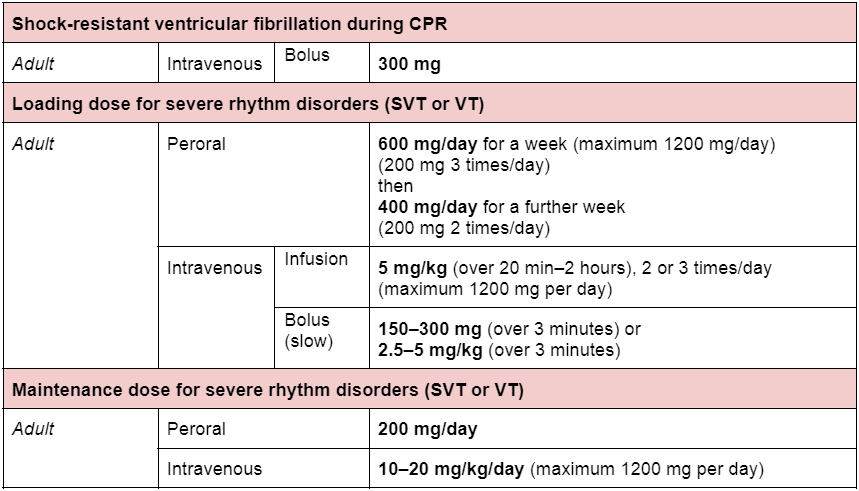
Amiodarone (Cordarone, Sedacoron)
Mechanism of action
- Primarily blocks potassium channels of myocardial cells which prolongs their repolarisation and refractoriness and slows the conduction in the AV node.
- Secondly, it interferes with many other channels and receptors – acts as a nonselective beta-blocker, blocks sodium and calcium channels, causes peripheral vasodilation and even binds to thyroid receptors.
Indications and dose

Pharmacokinetics
Onset of action: 7 days
Duration of action: 10 days to 1 month after withdrawal
Half-life of elimination:
- 3.2–20.7 hours after single dose
- 15–142 day after repetitive dosing
Metabolism: Hepatic (CYP3A4, CYP2C8) metabolization to desethylamiodarone (DEA)
Elimination: Liver
Directions for administration
Infusion: administration via a central line is recommended.
Peroral: patient should be switched to peroral medication once an adequate response from initial IV administration has been obtained. Consumption of high-fat food before administration enhances absorption.
Medicinal forms
Pills – 200 mg
Solution for injection/Infusion (50 mg/ml)
- 1 vial = 3 ml (150 mg)
Side-effects
Acute:
- Bradycardia
- Sinus arrest, sino-atrial heart block
- Hypotension
- QT interval prolongation
- Extrapyramidal tremor
Chronic
- Pulmonary fibrosis
- Hypothyroidism / Hyperthyroidism
- Photosensitivity, grey-blue pigmentation of skin (mostly face)
- Eczema
- Corneal microdeposits (asymptomatic)
- Sleep disorders
References
- Amiodarone Uses, Dosage & Side Effects - Drugs.com
- Pharm 101: Amiodarone • LITFL • Top 200 Drugs
- Amiodarone: Uses, Interactions, Mechanism of Action | DrugBank Online
- Amiodarone 200mg Tablets - Summary of Product Characteristics (SmPC) - (emc) (medicines.org.uk)





